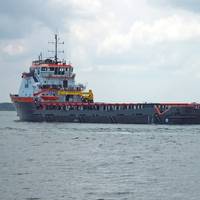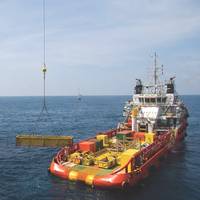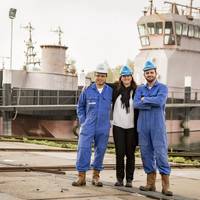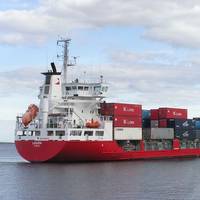US Government Boosts Oil Tanker Fleet in National Shipping Overhaul
The United States is boosting access to commercial products tankers as part of a security drive to safeguard oil shipping for its armed forces in times of crisis, a top Department of Transportation (DOT) official said.The U.S. flagged commercial fleet comprises a few dozen tankers with the majority involved in domestic trade and there has been concern over possible disruptions to the U.S. economy if those vessels were sought for use by the military, according to a Department of Defense study.The Tanker Security Program has aimed to charter 10 internationally trading vessels for 2023 that can move oil products. Each would receive an annual payment of up to $6 million and had to be U.S. operated and have U.S.
Steamship Authority Buys Two OSVs to Be Converted to Freight Ferries

The Woods Hole, Martha’s Vineyard and Nantucket Steamship Authority said it is planning to buy a pair of secondhand offshore supply vessels (OSV) to convert into replacements for two of its aging freight vessels.The sister OSVs, HOS Shooting Star and HOS Lode Star, will be purchased from Covington, La.-based Hornbeck Offshore Services. The 240-foot-long vessels, which were built in 2008 and 2009 respectively and formerly serviced the oil and gas industry off the Gulf Coast, will…
Panama Canal Expansion Allows More NGL Transists
In June 2016, the Panama Canal Authority, the body that operates the Panama Canal, opened a third set of locks that facilitated transit of larger ships, the first such expansion since the canal was completed in 1914.In the years since the canal was expanded, the largest change in petroleum flows through the canal has been the increase of hydrocarbon gas liquids (HGL), especially propane, from the U.S. Gulf Coast to destinations in Asia. HGL represents all natural gas liquids (NGL) and olefins.Most of the petroleum transiting the Panama Canal travels southbound from the Atlantic Ocean to the Pacific Ocean. Flows of HGL are the largest single petroleum commodity transiting the canal, according to data from the Panama Canal Authority.
WASHINGTON WATCH: A Tale of Two Fleets

Mixed Government Support for U.S. Shipbuilding.It has been a busy start to the 116th Congress for the U.S. shipbuilding industry, with three congressional hearings in early March focused on the industry’s role as a critical component of the U.S. national security industrial base. In addition, the Consolidated Appropriations Act, 2019, which was signed into law on February 15, contained mixed news for shipbuilding programs. Through the congressional hearings and enacted legislation, two opposing themes have emerged.
Vitol Stores Gasoline Aboard Ships off Singapore
Vitol seen storing gasoline off Singapore as local onshore light distillates stocks at record levels. European trader Vitol is storing gasoline on tankers offshore Singapore, Asia's biggest oil trading centre, for the first time since 2016 amid oversupply and weak demand for the fuel, said four people that participate in the market on Wednesday. The sources said that Vitol was seen storing gasoline aboard more than one so-called Long-Range (LR) tanker. The company does not typically comment on its trading operations. At least one of the vessels is the tanker Glory Crescent, a so-called LR-2 tanker, said one of the four sources. The vessel is 105,000 deadweight tonnes and could carry the equivalent of about 800,000 barrels of gasoline.
Preparation Propels Financial Peace of Mind

Like marine coatings, preparation is everything when it comes to sourcing and attracting marine finance support. If you’re familiar with the maritime industry at all, this won’t come as a shock: we’ve seen better days. Like many industries, this is one that goes up and down and, right now – depending of course on sector your focus resides – we’re pretty far down. This severe downturn began in late 2014 and we’ve seen many financing sources exiting the offshore market since. It seems that lenders have zero interest in lending into the U.S. Gulf of Mexico.
J.P. Morgan Raises Distressed Shipping Fund
J.P. Morgan Global Alternatives has closed a $480 million fund to invest in distressed shipping assets, attracting capital from pensions, endowments and insurance companies, reports Financial News London. The Global Maritime Investment Fund II, which surpassed its $400 million targeted capital raise, is one of the largest dedicated shipping funds. It seeks to invest, through a closed end structure, in modern vessels operating in shipping sub-sectors that are experiencing substantial distress, with values trading near historical lows. The idea is to pick up bargains in an industry that JP describes as a "workhorse" of the global economy.
'We Will Not Stand by and Wait for Global Regulation' -Maersk Line
Shipbreaking has become commercial due to the recycling of steel becoming a global commodity in demand. This means that the dismantling and recycling of a ship are recognized as part of the value of the ship, which has evolved into a massive challenge for the shipping industry. "The choice is clear. One option is to continuing to wait for global agreement – while hundreds of vessels continue to be dismantled on the beaches of India, Bangladesh and Pakistan – or to act now and begin improving the conditions in yards. That is what we have done in Maersk. We have chosen to no longer stand passively on the other side of the gate of the ship yard but instead engage directly where the majority of ships are dismantled.
Damen Trading Sale hits 500th Vessel
30 years and 500 vessels later, Damen Trading is just getting started. Damen Trading’s story begins in 1986, with Damen Shipyards Group responding to growing market demand for used vessels. Since then, Damen Trading has gone on to sell over 500 used vessels, right across the maritime spectrum, developing along the way a reputation for personalised, reliable service. The decision to establish Damen Trading was a logical one, says Senior Sales Manager Michel Radjiman “With Damen Marine Services already operating its own charter fleet, from the outset we had a lot of operational knowledge in-house. Mr Radjiman says every sale is unique.
Damen Trading Launches New Website

The new website for Damen Trading, the brokerage department of the Damen Shipyards Group, integrates Damen corporate house-style as well as an improved profile of services that includes registration, transport and even vessel modifications if required. It also offers trade-in terms for owners looking to buy a new Damen vessel. Damen Trading specializes in tugs and workboats with a global network consisting of ship owners, ship operators and co-brokers. Further services include the sale of coasters, crewboats, patrol boats and passenger ferries.
Langh Ship Develops Exhaust Gas Scrubber

Although the sulphur limit for ship fuel in the North Sea and Baltic Sea is 1%, Langh Ship’s m/s Laura sails in the area with whatever fuel the charterer has found in Rotterdam, no matter how high its sulphur content. This is possible because the shipping company has equipped the vessel with a closed loop scrubber that emits exhaust gas that is even cleaner than if the fuel had a sulphur content of no more than 0.1%. Environmental regulations in this sulphur emission control area (SECA) have been tightened such that the sulphur limit for fuel will drop to 0.1% at the start of 2015.
Wind Power Seen Surging as Custom Barges Cut Cost
Offshore wind-power producers from Dong Energy A/S to RWE AG are building custom ships at record rates to reduce the cost of the technology which is three times as pricey as electricity from coal plants. As many as 20 vessels, some with movable legs which reach the seafloor, will come onto the market in the next few years, reducing chartering costs of as much as 200,000 euros ($261,000) a day, said Marc Seidel, an offshore engineer at Suzlon Energy Ltd., which supplies turbines to Germany’s RWE. A lack of specialized installation ships has forced companies to hire barges designed for oil exploration, holding up work at projects such as EON AG’s Robin Rigg wind farm off Scotland’s western coast.
Finance: Equipment Leasing: A Viable Financing Option for Marine Industry
By James W. In recent years maximizing budget dollars has become an increasing concern for many businesses. Fortunately marine assets have long, useful lives, but the debt required to finance their acquisition often creates a strain on the operator's balance sheet and cash flow. According to the Equipment Leasing Association (ELA), 8 out of 10 businesses in the United States lease some kind of equipment. However, fewer know that leasing, accomplished through a bare-boat charter, is also a smart business decision for obtaining vessels. Because marine assets have long lives, lease payments can be relatively low. Companies can use these cost-savings to improve day-to-day cash flow or to gain a competitive edge by passing the cost-savings along to customers.
Effectively Assessing Your Risks
One of the greatest challenges facing a lender in the maritime industry is appropriate assessment of risk. In this exciting, varied and vibrant industry, a lender's effective risk assessment requires a thorough understanding of the vagaries that characterize the industry. Many of the companies have been in business for 100 years or more. They have a long family history associated with the sea that has charted their economic destiny for decades. Experience and expertise are the key factors in designing a successful strategy to serve the maritime market, which is made up of skilled professionals who know their business from A to Z. Vessel owners also are proud of their company history.
Effectively Assessing Your Risks
One of the greatest challenges facing a lender in the maritime industry is appropriate assessment of risk. In this exciting, varied and vibrant industry, a lender's effective risk assessment requires a thorough understanding of the vagaries that characterize the industry. Many of the companies have been in business for 100 years or more. They have a long family history associated with the sea that has charted their economic destiny for decades. Experience and expertise are the key factors in designing a successful strategy to serve the maritime market, which is made up of skilled professionals who know their business from A to Z. Vessel owners also are proud of their company history.
Stolt-Nielsen to Buy 3 Used Tanker Ships
The AP has reported that Stolt-Nielsen SA is buying three used tanker ships for about $40 million. The company said its wholly owned subsidiary, Stolt-Nielsen Transportation Group, has exercised an option to purchase the tankers, currently on charter, from Montana Ship Holding AS. According to Stolt-Nielsen, it chartered the ships in December 2001 with an option to buy at any time. The company said the three ships are to be converted at a cost of $7.5 million to meet new safety regulations that will take effect Jan. 1 next year. Stolt-Nielsen said it anticipates the ships will allow it take advantage of growth prospects for the parcel tanker market. It also said the used vessels will help it save money since the cost of shipbuilding is at historic highs.
Commercial Marine Engine Emission Standards Finalized
EPA Administrator Carol Browner signed a final rule establishing new emission standards for commercial marine diesel engines at or above 37 kW (approximately 50 hp). EPA's final rule aplies emission standards to new engines only, beginning with the 2004 model year. Vessels and engines built before 2004 will not be subject to emission control requirements. However, if a vessel is subsequently modified such that 50 percent of the modified vessel's value is derived from new material or components, the vessel will be considered new and will be required to meet engine emission standards in effect at the time the modifications are made. EPA believes this will prevent companies from re-using parts from used vessels to avoid emission standards.









